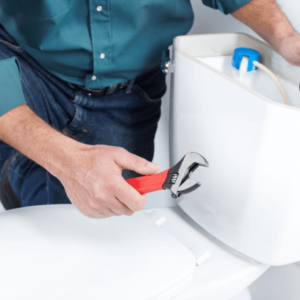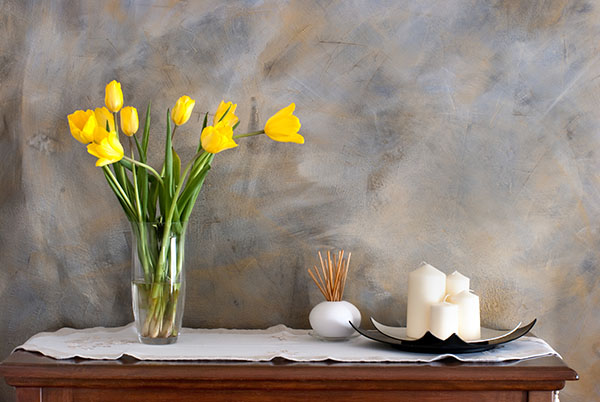Faux finish painting is a technique that creates texture and nuance by replicating the look or feel of other surfaces, such as striped wallpaper, suede, or marble. While it takes some patience and creativity to successfully complete a faux finish project, the results will convince you that the work and amount of time spent were worth it. Here are a few of the most common faux techniques.
Basic Faux Painting Techniques
Sponging
Sponging is perhaps the easiest decorative technique to learn. All it takes is a natural sea sponge, glaze, and two or three colors of paint to add dimension, color, and texture to any room, whether it’s the kitchen, bathroom, or bedroom.
Before sponging the wall, apply True Value EasyCare Ultra Premium Interior Primer/Sealer using a roller applicator. Let the primer dry completely and then apply a base coat of True Value EasyCare Ultra Premium Interior Paint in the color of your choice.
Dip a damp sea sponge into a glaze/paint mixture and lightly dab the mixture in a random pattern on your wall. To achieve a subtle effect, use a glaze color from the same color family of your base color. For a bolder effect, use a glaze color from a different color group.
Color Washing

Color washing, or “broken finish” technique, can bring authentic old-world charm to any room, making it feel as if it’s weathered by time. Yet it’s amazingly simple to do. Just apply a thin, translucent glaze over a contrasting base color and use feathery brush strokes to produce a mellow, soft texture. It’s a great look in a kitchen, family room, den, or master suite.
To begin, prime the surface with True Value EasyCare Ultra Premium Interior Primer/Sealer and a roller. After the primer has dried, apply a base color using True Value EasyCare Ultra Premium Interior Paint. Let the base coat dry.
Apply a glaze/paint mixture with a rag or sponge using a wiping or circular motion — like you are washing the wall. Once you’ve achieved the look you want, let the top coat dry.
Rag Rolling

Achieve the rich look of old leather or weathered stucco with rag rolling. Simply use a twisted or bunched-up rag to roll paint on or pull it off irregularly, to create a mottled effect. Whether you want something subtle or bold and dramatic, rag rolling is a simple way to make a big impact on walls in any room.
To “roll on” the effect, apply a base coat of True Value EasyCare Ultra Premium Interior Paint with a roller. Let this coat dry completely. Wet a rag or cloth and wring it out well. Dip it into the glaze until the rag is saturated. Roll and twist the rag or bunch it up in a ball and roll the rag across the surface. Reload the rag as needed. You can add a second glaze color after the first has dried, if desired.
To use the “roll-off” method, repeat the first steps and then apply glaze with a roller or brush. Roll a damp, clean rag over the glazed surface which will irregularly remove the glaze and create the desired effect. Rinse and wring out the rag when it becomes saturated by the glaze or use a new, clean one. Once you’ve completed all the walls, let the top coat dry.
Advanced Faux Painting Techniques
Marbleizing

The rich color variations, veining, and intricate patterns of natural marble are the inspiration for this technique. Marbleizing is the process of layering tinted glazes over a base coat to produce the appearance of real marble. It can enhance fireplace surrounds, tabletops, picture frames, and of course, walls. It does take some time and effort, but with a little practice, you can achieve effects that a stonemason might envy.
First, prime the surface with True Value EasyCare Ultra Premium Interior Primer/Sealer using a small roller applicator. Keep a small, angled paintbrush for hard-to-reach areas and edges and to fill in any areas the roller missed. Let the primer coats dry completely.
After choosing the marble color you want, using a small roller applicator, paint a base coat of that color using True Value EasyCare Ultra Premium Interior Paint in a flat or satin finish, in a lighter shade than your base color. Use a painting sponge or a bunched-up rag and a slightly darker shade of your basecoat to create mottling or the blotchy pattern of marble. Dab and smear the surface with the paint-covered sponge. Be creative in your strokes; try not to use the same pattern across the counter. Let this coat dry. Add the look of veins using assorted sizes of artists’ brushes to add to the realistic marble appearance. Use different paint colors as well, such as white, gray, or black to get the effect you’re looking for. Move the brush with uneven, diagonal strokes making “Y” or “K” shapes, taking care to not make them too straight or too uniform. Consider strengthening your veins by reinforcing lighter-colored ones with darker colors and vice versa. Let these dry.
Add a layer of glaze using a mini-roller. This provides a crystalline shine like polished stone to complete your faux-stone look. When the glaze has dried, add a couple of coats of polyurethane varnish or sealant to enhance the shine effect of your faux-stone painting and protect it. Apply the varnish using a roller or large paintbrush, using a small brush for hard-to-reach areas or places where you need finely tuned strokes. Let this dry completely.
Faux Granite

Granite is a popular stone today because of its sophisticated style. There is virtually no limit to the colors and pattern variations of granite, so you can really express yourself with the faux granite painting technique. The process combines sponging and speckling a glaze mixture onto the surface to replicate the patterns of granite. It works well on countertops, furniture, floors, and walls.
First, prime the surface with True Value EasyCare Ultra Premium Interior Primer/Sealer using a small roller applicator. Keep a small, angled paintbrush for hard-to-reach areas and edges and to fill in any areas the roller missed. Let the primer dry completely.
Choose the granite color you want, and then use a small roller applicator to paint a base coat of that color using True Value EasyCare Ultra Premium Interior Paint in a flat or satin finish, in a lighter shade than your base color.
Choose three accent colors appropriate for the base color. Remember you want the colors to be natural-looking, for example colors that often appear in granite, so do your research on how granite actually looks. Pour a small amount of the first color into a paint tray and then use a painting sponge to create splotches of one of these colors onto your base coat across the entire surface of the countertop. As with faux marble, dab and smear paint on with the sponge. Let the paint dry. Repeat this process for the second color. Make sure that you let each color show through. Pour the third accent color into a paint tray and add a little bit of water. This time you’ll dip a small- to medium-sized paintbrush into the paint/water glaze you made and then lightly shake the brush over the countertop to splatter the surface with tiny specks of paint. For more precise detail, you can run your fingers (wear rubber gloves) across the ends of the bristles to flick or mist the paint into tiny specks across the surface. Let the paint dry. Some granite patterns include veining in the same way as marble. If you want this effect, just follow the same procedure as you would for marbleizing.
Add a layer of glaze to the countertop using a mini-roller to add a crystalline shine like polished stone to complete your faux-stone look. Cover the entire surface of the countertop as you did with the primer and basecoat of paint. Let this glaze coat dry.
Add a few coats of polyurethane varnish or sealant to enhance the shine effect of your faux-stone painting and protect it. Apply the varnish using a roller or large paintbrush, using a small brush for hard-to-reach areas or places where you need finely tuned strokes. Let this dry completely.
Crackling

Want an aged, weathered look on a surface such as a door, chair or table? Crackle faux painting techniques can provide real attention-getting style and create a focal point in a room. This method uses two colors of paint, a crackle medium, and varnish to create the desired effect — an instant “country” or distressed look to your selected surface.
Apply a base coat of True Value EasyCare Ultra Premium Interior Paint using a roller. Let the base coat dry completely. Continue by applying a coat of crackle medium to the surface with a paintbrush. Let the crackle coat dry for the manufacturer-recommended amount of time.
Use a roller to apply a top coat of True Value EasyCare Ultra Premium Interior Paint in a flat finish. As this coat dries, it will begin to crack and show the base coat underneath. After a couple of days, apply an acrylic sealant to protect the crackling paint.
Strié Technique

You could spend a fortune on real fabric wall coverings, or you can try the faux painting technique known as “strié” or dragging. Dragging is just that — pulling a brush through a colored glaze that has been applied over a base coat. It’s a luxurious, high-end look that you can master in no time.
Apply True Value EasyCare Ultra Premium Interior Primer/Sealer with a brush or roller and let it dry thoroughly. You also can skip priming and save some time by painting with True Value EasyCare Ultra Premium Interior Paint. Apply a base coat using the same technique you used for priming, if you did so. Let the paint dry completely.
To achieve the strié effect, your glaze topcoat should be in a different color than the base coat so that it contrasts. Apply an acrylic glaze/paint mixture over the topcoat, using a roller or brush, in vertical strokes from top to bottom. Do small sections of the wall at a time so that the glaze doesn’t dry prematurely. Then, lightly drag a large, long-bristled paintbrush through the coat of glaze/paint from top to bottom in long, soft, vertical strokes. Wipe the brush on a rag and then repeat the process along the rest of the wall, slightly overlapping the previous section each time. Let the glaze coat dry completely.
Diamonds

A diamond pattern on either an accent wall or in the entire room can be fun and casual, or elegant. While it necessitates careful preparation, this technique can add an incredible ”wow” factor to a bedroom, hallway, vestibule or dining room. To achieve this effect, you apply a lighter colored base coat and then create a tape grid of diamonds, filling them in with either a contrasting color or another finish in the same color as the base.
Determine how large you want your diamonds or the pattern to appear. Measure your wall. Divide the width by the number of diamonds you want. This will determine the width of each diamond. Multiply that number by two to determine the diamond height.
Paint a base coat of True Value EasyCare Ultra Premium Interior Paint in the lightest color you chose. Let the base dry completely. Sketch out the diamonds on the wall, using a level, a measuring tape, and a pencil. Use these lines as a guide to applying painter’s tape around the area to be painted, creating the diamond.
Use a mini-roller or small paintbrush to fill in the masked areas. Let the paint dry completely and then carefully remove the painter’s tape.
Stripes

Stripes are a classic design element that can add interest to any room. Adding stripes to your walls with paint is a technique that gives you the freedom to create original, personalized vertical or horizontal patterns that reflect your taste and lets you customize the colors to match your décor.
Plan out your design — do you want vertical or horizontal stripes? Do you want to paint them on an accent wall or throughout the whole room, or something else outside the box? Choose a color scheme. It’s common to choose two shades of the same color, but you don’t have to limit yourself. For a bolder effect, try contrasting colors that complement one another. For a more subtle striping effect, use the same color for the basecoat and the stripes, but in different finishes. You can be more contemporary by using stripes in varying widths.
Apply a base coat of True Value EasyCare Ultra Premium Interior Paint with a roller or paintbrush, in the lighter of the two colors you chose. Allow the area to dry completely before painting the stripes.
To create vertical stripes, use a ruler, yardstick, or measuring tape, and a pencil to measure and mark even intervals along the top edge of the wall. Do the same along the bottom of the wall, marking the exact same measurements as the top. Continue along the length of the entire wall. Use painter’s tape to mask out vertical lines starting from the top marks to the bottom marks. These will form the outside edges of each of your vertical stripes.
Horizontal stripes are made in a similar fashion. Measuring with a yardstick and level, mark where you want the topmost stripe to be from the ceiling. Trace a line with your pencil along the top of the yardstick. Continue creating this line in the same way across the length of the wall. Using the same technique, create the rest of your horizontal stripe pattern as wide as you want your stripes to be.
Apply painter’s tape to the lines you made in pencil on the “outside” of the lines. Continue the process until you’ve masked all the stripes. This will keep you from painting over the lines and ruining your base coat. Using a small or medium-sized paintbrush, carefully apply the second color or finish, making sure to keep within the lines you made with tape. Let the paint dry completely before removing the painter’s tape. Pull the tape away from the wall gently in a downward, angled motion.
Other Faux Techniques
Antiquing

“Antiquing” is a great technique to use on furniture, cabinetry, or anything else you want to give an aged or distressed look. All it takes is a base coat of paint and some glaze. Enhance your interior design with a feature piece with unique beauty and personality.
Antiquing is usually done with darker, earth-toned glazes layered over a light-colored base coat such as yellows, creams, or beiges. But if you prefer the look of a lighter glaze, you can pair it with a dark base coat instead. Use a flat finish for your base coat. A porous finish absorbs glaze better than the satin or eggshell varieties. For your glaze mixture, use a satin finish in the same color.
Apply a base coat of True Value EasyCare Ultra Premium Interior Paint. Allow the surface to dry completely. Apply a paint/glaze mixture (1 cup, satin finish paint to 2 cups glaze) over the base coat and let it dry for a bit. The finish will begin to appear dull. Then use a damp piece of cloth to begin wiping away the glaze mixture in long, even strokes. Replace the cloth with a clean one when it becomes too saturated. You can also wipe off the mixture with rolled-up plastic wrap, newspaper or cheesecloth for different textures and effects. Remember not to wipe off so much that you lose the desire effect. Allow the surface to dry completely and then add a coat of polyurethane sealant to protect the finish.
Lime Washing

The “scrubbed-chalk” finish has been popular since the medieval period. You may know it by its better-known name: “Whitewashing”. This faux finish duplicates a uniquely aged look and is versatile enough to be used for period rooms as well as modern interiors. For instance, lime washing looks great in a kitchen or porch, but works equally well in a bathroom or bedroom. This process also has the advantage of a short drying time.
Actual whitewashing requires the use of lime, which is caustic and not ideal. This faux technique replicates the effect without using lime. This effect usually works best on unfinished wood.
Mix together True Value EasyCare Ultra Premium Interior Paint in a flat finish with water. You want the solution to dry with a chalky look, so the consistency of the mixture should be a creamy texture. More water will create a thinner finish. Apply the mixture to the surface with a paintbrush and then let it dry completely. Finish with a latex varnish to protect the surface.
Pickling Wood

Pickling is a technique that provides results similar to lime washing, in that it makes wood appear lighter in color — a “bleached” look of driftwood. This technique is pretty simple.
Start by sanding the wood with medium-grit sandpaper. Create a mixture of True Value EasyCare Ultra Premium Interior Primer/Sealer and water (mix 1 part white primer with 3 parts water). Then apply this solution to the wood using a paintbrush in small sections. Next, use a clean dry cloth to rub the solution into the wood against the grain. Then use a new rag to wipe along the grain to remove excess solution. Let it dry and then finish with a coat of clear acrylic sealant.
Stenciling

Stenciling is perhaps the most widely used decorative painting technique and it’s something almost anyone can do. Border a too-small window to make it appear larger. Use a border on a wall just below the ceiling to warm up a cold room or to make a high-ceilinged room look cozier. If you like the look of a chair-rail molding but aren’t up to the carpentry involved, try a stenciled border there. Choose colors that coordinate with your furnishings.
Faux Stenciled Wood

If you have wood flooring in your house, stenciling can turn it from plaint wood to “wow”. Stenciling is unique, it matches your room perfectly and it is more artistic than area rugs as the centerpiece to any room. Plus, it even covers up scratch marks. One thing that you need to decide is if you want to design your own stencil or buy it ready-made. If you have an abstract design in mind you probably want to design your own stencil, which is easy to do and cheaper than buying ready-made stencils. However, if you have a design that you can’t draw, buying ready-made is the better choice. There are a wide variety of ready-made stencils in many different styles that could complement your room, and they’re easy to find at your local True Value Hardware Store.
Verdigris Finishing

Create the look of aged bronze or copper on accent pieces with the verdigris technique. The term “verdigris” comes from the French phrase “vert de Grece,” which means “The green of Greece.” True verdigris is actually created by a coating of the cupric carbonate formed on weathering copper, brass, and bronze from age. The beautiful blue-green patina, which can be seen on historic domes and spires, lends an ancient, soft and chalky aspect to decorative metalwork.
Start by cleaning and sanding the surface. Your first coat of paint should be a metallic copper or gold hue. After this coat has dried, apply a coat of dark green paint using a sponge. Don’t worry about coverage; you want the copper color to show through the green. When the dark green paint has dried, apply a coat of light green paint with a sponge irregularly. Blot the paint with a rag or paper towel to increase the mottled effect. Let it dry. Finish by applying a coat or two of clear acrylic finish to protect your work.
Wood Graining

Wood graining is a centuries-old painting technique used to simulate the appearance of wood. This dramatic technique can be easily applied to doors, painted furniture or interior trim molding.
Apply a base coat of True Value EasyCare Ultra Premium Interior Paint. Let it dry completely. Add a thin coat of glaze using a roller in small sections at a time. Use a wood grain rocker to create the wood grain effect in the glaze. Let the glaze dry.












